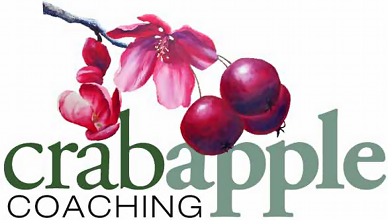 Thoughts from a Retirement Coach
Thoughts from a Retirement Coach
By Mariella Vigneux, MBA, ACC
Certified Professional Coach
Our cat died. Lola. I was taken by surprise that we didn’t have a few more years together. Twelve years isn’t old for a cat. But she got sick and we had to have her euthanized. I loved her.

Lola (Photo by Alysha Brilla)
She spent her days curled up on my desk, periodically nudging me as I worked. She slept between my feet at night. A sweet, gentle, loving cat. And very pretty, all black and white, with luminous green eyes. I miss her.
What struck me about my grief for her is how wide it swung open the gate to the graveyard in my mind. It brought back memories of burying Maggie, our beautiful black lab. Past cats – Esther, Johnnie, Tiger, and Crusher. Then came memories of my father struggling for breath during his last hours on the hospice bed. And the memory of putting a pair of socks on my mother’s cold feet after she died. I hadn’t gotten to her bedside in time. These memories, all tightening the already crushing grip around my heart.
Who wants to compound the enormous sadness of one death with memories of all the preceding deaths! No fun. Not fair. Not nice. Close – that – gate!
But isn’t it all part of getting older? It comes with the territory. Right? We’ve lived long enough to have loved many. And to have lost many. I don’t know anyone my age who hasn’t lost at least one parent, friend, pet, partner, sibling or – chilling thought – child.
The gate latch to the graveyard
The first time the graveyard gate swung open for me was on the last day of work at summer camp, 1979. The campers had left. Out of the blue, I broke down crying. I was suddenly remembering my neighbours who had died the year before. They were part of a family that lived across the courtyard, a family of 13, similar to my own, a family I had once helped my sister to babysit. I remember the phone call from my mother. She said, “Are you sitting down? You should sit down.” She proceeded to tell me that five of the 11 children had died, along with their mother. Their house had caught fire, and smoke had billowed up the circular staircase from the basement. I heard later that these five kids were huddled by an upstairs bedroom window, with their 44-year-old mother’s arms around them. I remember my stunned incomprehension. Who died? Which ones did she get out the window? Who rolled off the roof into the flowerbed? In which bedroom were they found? I also remember the funeral, and the six white coffins, some of them very small.
My friend at camp asked me, “Don’t you think remembering those kids has something to do with the fact that all the campers have just left?”
Ah. The trigger… the gate latch to the graveyard in my mind, where this family’s tragedy accounts for six tombstones.
It’s a place I don’t visit very often, and only when it has been forced upon me by a new grief.
Counting the discounted griefs
It is not only deaths that I bury deep in my memory. I entomb many discounted sorrows, one’s often overlooked: a lost pre-term baby, broken relationships, job loss, parenting mistakes, mental health diagnoses of loved ones, the turmoil of my father’s last months… all buried in a grieving ground in my mind.
Yesterday, I met a mother whose youngest son recently lost two fingers in an industrial accident. The accident terminated his chosen career path. He’s obviously a figure for my sympathy, but I want to acknowledge the suffering she is still experiencing.
Reliving the anguish, not so much the loss
I’ve come to realize that this graveyard in my mind is really the place where I relive the anguish that came at the time of the losses, more so than a place where I mourn those who died. I relive the grim realities… having to choose the colour of taffeta for my mother’s coffin; having to lower our dog into a hand-dug grave. It is where I relive my violent crying at my mother’s funeral, which soaked the shoulder of my bewildered cousin’s suit jacket. I relive seeing my big, baby brother overwhelmed by grief. The wait for a diagnosis; the I-have-some-bad-news phone call; the decision made to let them die. These newly experienced, newly learned emotions are powerful and distressing. They are what create the tombstones.
This graveyard, though, isn’t where I keep the happy memories of the people and things I loved and lost. These memories belong to a brighter place, where the sun warms my shoulders and a breeze litters the grass with crabapple blossoms. This place is where I can remember Lola purring in my hammock.
Losses and founds
My inclination is to keep the gate to the painful place closed and locked, unopened until the next loss. Ignoring the graveyard is one way to deal with the pain associated with loss. But I’d rather find some real value to these painful memories. What messages are they sending?
I was helped in this by my friend Martin. He was with me the day I took Lola to the vet that final time. A couple of weeks later, he and I had a long talk, over too much coffee, and, although my synapses were misfiring from the caffeine hits, I came away with these thoughts.
As Martin said, the level of pain we have when we lose someone or something is testimony to the value of the attachment. The pain is a sharp reminder of what we hold dear. If we understand what we were so attached to, we can then consciously bring those things into our future life.
For example, what was I attached to in Lola? Sweetness, gentleness, a loving spirit, and beauty. And something to love. So how can I bring those qualities into my future?
What was I attached to in the family members who died in the house fire? Perhaps they represented my own family; the fire could well have been in our house and I could have lost five of my brothers and sisters. So, what am I attached to in my siblings – what are we giving each other? Big-hearted loving, ridiculous humour, intelligent conversation. If I were to lose them, how would I bring those things into my future life?
Becoming soft and malleable
Martin admires people who become soft and malleable as they age, rather than rigid and fixed in their ways. Almost like shape shifters, their softness comes from not holding on too tightly to life’s constructs. They learn from their losses and shift shape to recreate a life that accommodates those losses.
I like that idea. By not being rigidly tied to what was, I can be open to what I can become. Like a shape shifter, I can be soft, retaining aspects of what I lost, but in new shapes, in my new life. I can hold onto what I loved about those I lost, but let go of the rest. Maybe that is how the pain of loss can be of value.
I’m hoping that the graveyard may someday become a softer, more peaceful place. I think I’ll have to grow more malleable and softer myself, though, before that happens. By which time perhaps I’ll have learned to grieve more gently and the tombstones, themselves, will have softened over time.

Beautifully insightful, Mariella.
Thank you for treading the same difficult path in order to write this article that you’ve walked down when facing death and difficulty. You help illuminate the way.
Martin
Aw, thanks, Martin.
Your beautiful use of imagery has made these concepts easier to bring out and explore in the light of day. Thank you for the gift of sharing your transparency in these memories and providing us with a window into your soul.
Lynne, it took me a bit of soul searching to come to some understanding of why I keep revisiting the painful memories that come with losses. Thanks for you kind words.
Mariella, I think this is a brilliant piece of writing. Both the ideas (and thanks to Martin too) and the way you wrote about them. I want to remember what you wrote and apply it to my own life.
Hi praise, indeed! Thank you, Amy. I’ll pass your thanks on to Martin.